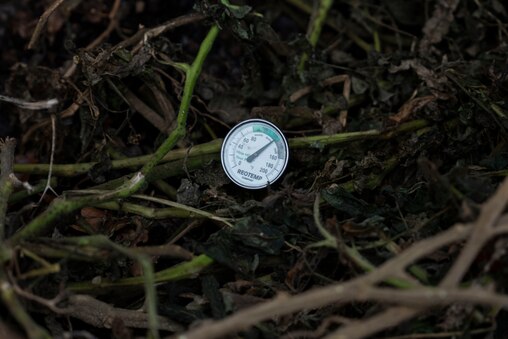Tucked in an out-of-the-way stretch of the Maryland Zoo in Baltimore are several large containers of animal poop. They reek — of opportunity.
Normally Baltimore City crews scoop poop stored there into an incinerator in South Baltimore. But that wasn’t the No. 1 way the zoo’s sustainability team wanted to deal with all that No. 2.
So in February they worked out an arrangement with the Rockville-based food composting company Compost Crew. Workers began delivering the waste to a biodigester in Jessup that could turn the stinky problem into fresh products that include fuel and fertilizer.
“There is giraffe, rhino and antelope waste in there, and some elephant, but they make a lot of poop, and for logistical reasons we can’t manage to compost it all yet,” said Kat Mantzouris, the zoo’s conservation programs manager. “We’re at 30%. The dream is 100%.”


She said there was a year’s worth of planning to figure out weekly pickup and delivery of the waste, which is transported in those long metal containers that can roll on and off a truck. The digester’s operator, Annapolis-based Bioenergy Devco, also needed to ensure the digester could handle waste that included hay bedding and food scraps from animals and humans, along with the occasional pile of compostable cutlery and plates.
And the zoo had to budget for it. The city takes all the zoo’s waste for free since it’s housed on city property. Sending it to Jessup costs $500 a week, and the zoo doesn’t yet get any of the digested products in return. The fuel goes into the natural gas system of Baltimore Gas and Electric.
Though it’s far more common among farms, a growing number of zoos — including those in Detroit, Cincinnati and Houston — are tapping digesters to divert their waste from landfills and incinerators. Like the Maryland Zoo, they just couldn’t flush those resources.
The poop program is part of the sustainability plan at Baltimore’s zoo, which also includes composting food scraps on-site, developing rain filters and water conservation systems, and growing leafy greens and other crops to feed animals.




The zoo works with BGE to identify desirable tree species trimmed from power lines that could be tasty snacks for herbivores.
Legal action is playing a role in the growing use of digesters and composters. A Maryland law that took effect this year requires any person or business that produces more than two tons of food waste a week to divert it from landfills. Next year, it’ll be anyone producing one ton.
Many are turning to composting, a better-known, cheaper and simpler alternative. Composters use oxygen to break down food scraps into nutrient-rich soil, a process that can be done in a box. They can’t accept poop because bad bacteria can persist and make the fertilizer unusable.
Digesters, on the other hand, use bacteria, like the kind in the human belly, to digest food, poop and other organic matter in airtight containers. The results are solid fertilizer, often for use at farms where the poop comes from, but also a liquid fertilizer that can be sprayed on crops and absorbed quickly.
Perhaps most important, the digesters also capture the climate-warming gas methane (think cow and elephant farts) and turn it into renewable energy. The renewable fuel can be used for heat or light directly, or, like the Jessup digester, fed into the supply lines for natural gas, a nonrenewable energy.



The U.S. Environmental Protection Agency and the U.S. Department of Agriculture promote use of digesters through a program called AgSTAR that offers access to technical and financial assistance.
Stephanie Lansing, an assistant professor in the University of Maryland’s College of Agriculture and Natural Resources, says the cost to develop facilities remains the biggest barrier.
She has been working on smaller and cheaper digesters on farms in Maryland, and she and colleagues recently completed an assessment of waste technology for the Maryland Department of Agriculture.
Digesters are efficient, turning poop into products in as little as days, though big elephant droppings filled with fibrous hay would likely take longer than tiny pellets from giraffes. (Sorry, Caesar, there is just no privacy in the Maryland Zoo bathroom for giraffes anymore, is there?)
Lansing predicted that there would be more big and small digesters built on Maryland dairy farms and elsewhere because they have a large impact on greenhouse gases and reduce the need for landfills.
“We don’t have many in the system here; there are more in New York and California, and in Europe,” Lansing said.
“The technology is there,” she said. “There will be more when there are more carrots and sticks, incentives and laws, and that’s starting. But for now there is a significant upfront cost.”
Dan Israel, head of sales and marketing for Compost Crew, said the zoo was among the company’s first digester clients, a list that includes big producers of food waste such as Jessup-based Elite Spice.
Until the Jessup digester opened last year, there wasn’t an option near the zoo, and trucking waste long distances undermines the benefits. Compost Crew still takes most food scraps collected in Maryland, Virginia and Washington, D.C., to other composting facilities.
“This region has plenty need for more [digester] capacity for organic waste,” Israel said. “We’re supportive of building out that capacity.”
As for the zoo, Mantzouris said officials would like to have some kind of system on campus to process more poop. For now, as long as nature keeps calling, it’ll keep hauling.



Comments
Welcome to The Banner's subscriber-only commenting community. Please review our community guidelines.